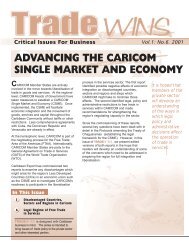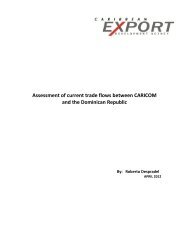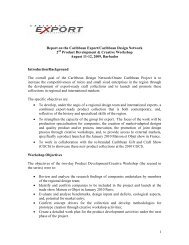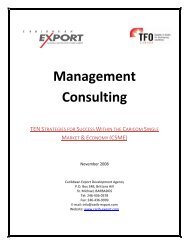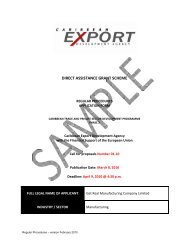The Furniture Manufacturing Industry of Barbados - Caribbean ...
The Furniture Manufacturing Industry of Barbados - Caribbean ...
The Furniture Manufacturing Industry of Barbados - Caribbean ...
You also want an ePaper? Increase the reach of your titles
YUMPU automatically turns print PDFs into web optimized ePapers that Google loves.
4. Analyse competitors costs, prices and <strong>of</strong>fers<br />
5. Select a pricing method<br />
6. Set the final price<br />
Many <strong>of</strong> these parameters yet need to be set or determined (starting right from the very furniture<br />
models that are to be promoted) and the actual pricing will have to be done at a later<br />
stage. In doing so the procedure above can provide a guideline.<br />
<strong>The</strong> following considerations might guide the pricing process for “Barbadian Vernacular”:<br />
ad 1.: Defining the pricing object: What is the strategic objective when selling “Barbadian<br />
Vernacular” furniture? Is it to secure the survival <strong>of</strong> Barbadian furniture manufacturing industry<br />
and to make sure it gets a foot in the door <strong>of</strong> the international antique (reproduction)<br />
furniture market? In that case an “interesting (i.e. low) price” might be warranted. Or is the<br />
aim to maximise pr<strong>of</strong>its from selling the furniture in the near future? Or: to penetrate the<br />
market and to secure a substantial market share in the longer run (at the expense <strong>of</strong> immediate<br />
benefits)? Or (finally): to become product-quality leader, something that requires a very<br />
long term commitment, investments in machinery, training and a refinement <strong>of</strong> technologies.<br />
Entering the market with comparatively high prices secures a position in the upper third <strong>of</strong><br />
the set <strong>of</strong> strategies depicted in Graph 6. But, to become product-quality leader in a market<br />
(or a segment there<strong>of</strong>) requires a particularly long-term commitment.<br />
ad 2.: Assessing the demand: Assessing the existing demand for a given (yet to be determined)<br />
product is crucial to establish its price sensitivity. Each price will lead to a different<br />
level <strong>of</strong> demand; the relation between alternative prices and the resulting demand is capture<br />
in a demand curve. Generally speaking, customers are less price-sensitive to items they buy<br />
infrequently such as furniture. Also, customers are not so price-sensitive if the product is<br />
distinctive, has no substitutes, or products that are assumed to be <strong>of</strong> high quality, prestige or<br />
exclusiveness. All <strong>of</strong> this applies to “Barbadian Vernacular” furniture and can be interpreted<br />
as a justification for a rather high level <strong>of</strong> prices.<br />
ad 3.: Estimating the cost: Bearing in mind the limitations <strong>of</strong> the Barbadian furniture industry<br />
spelled out in the first part <strong>of</strong> the report (lack <strong>of</strong> raw material, high fixed and variable<br />
costs, obsolete machinery, deficiencies in the training <strong>of</strong> young pr<strong>of</strong>essionals) it will not be<br />
possible to <strong>of</strong>fer the furniture at “economic”, “good-value” or “super-economic” prices.<br />
Costs set a floor to the price and for “Barbadian Vernacular” furniture it will need to be medium<br />
to high to make any pr<strong>of</strong>it.<br />
ad 4.: Analysing competitors costs, prices and <strong>of</strong>fers: An extended search on the internet<br />
has revealed that competitors in the field <strong>of</strong> antique reproduction furniture follow a highvalue<br />
or premium strategy when pricing their products. This does not mean that the same<br />
strategy will have to be followed for “Barbadian Vernacular”, however, it provides a good<br />
justification to do so – if this should be the target suggested by the other analytical steps described<br />
here.<br />
ad 5.: Selecting a pricing method: with the information <strong>of</strong> steps 1 to 4 at hand the price can<br />
be calculated either by a standard markup on the calculated price per unit or by setting the<br />
price so that it yields a target rate <strong>of</strong> return. As an alternative, pricing can be based on the<br />
perceived value <strong>of</strong> the furniture (i.e. the value proposition that the customer is ready to accept).<br />
Perceived-value pricing works best with value buyers (for whom value matters more






